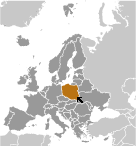World Atlas: Poland. On this page you can see the map, country flag and many detailed information about the people, history and economy of Poland.

Here you can find online selected information about the geography, inhabitants, government, economy and history of Poland. Included are selected statistics, an overview map and the detailed map of Poland. But let's start with the flag of Poland here:
Poland - Overview:
What you should know about Poland? Let's start with this: Poland's history as a state began near the middle of the 10th century. By the mid-16th century, the Polish-Lithuanian Commonwealth ruled a vast tract of land in Central and Eastern Europe. During the 18th century, internal disorders weakened the nation, and in a series of agreements between 1772 and 1795, Russia, Prussia, and Austria partitioned Poland among themselves. Poland regained its independence in 1918 only to be overrun by Germany and the Soviet Union in World War II. It became a Soviet satellite state following the war, but its government was comparatively tolerant and progressive. Labor turmoil in 1980 led to the formation of the independent trade union "Solidarity" that over time became a political force with over 10 million members. Free elections in 1989 and 1990 won Solidarity control of the parliament and the presidency, bringing the communist era to a close. A "shock therapy" program during the early 1990s enabled the country to transform its economy into one of the most robust in Central Europe. Poland joined NATO in 1999 and the EU in 2004. With its transformation to a democratic, market-oriented country largely completed and with large investments in defense, energy, and other infrastructure, Poland is an increasingly active member of Euro-Atlantic organizations.
Geography of Poland
 Where on the globe is Poland? The location of this country is Central Europe, east of Germany. Total area of Poland is 312,685 sq km, of which 304,255 sq km is land. So this is quite a large country. How could we describe the terrain of the country? This way: mostly flat plain; mountains along southern borde. The lowest point of Poland is near Raczki Elblaskie -2 m, the highest point Rysy 2,499 m. And the climate is temperate with cold, cloudy, moderately severe winters with frequent precipitation; mild summers with frequent showers and thundershowers.
Where on the globe is Poland? The location of this country is Central Europe, east of Germany. Total area of Poland is 312,685 sq km, of which 304,255 sq km is land. So this is quite a large country. How could we describe the terrain of the country? This way: mostly flat plain; mountains along southern borde. The lowest point of Poland is near Raczki Elblaskie -2 m, the highest point Rysy 2,499 m. And the climate is temperate with cold, cloudy, moderately severe winters with frequent precipitation; mild summers with frequent showers and thundershowers.
Inhabitants of Poland
Let's take a look how many people live in Poland. The number is: 38,476,269 (July 2017 est.). So quite a lot people live here. Who lives here? Polish 96.9%, Silesian 1.1%, German 0.2%, Ukrainian 0.1%, other and unspecified 1.7%. What are the languages in Poland? Polish (official) 98.2%, Silesian 1.4%, other 1.1%, unspecified 1.3%. And the religions: Catholic 87.2% (includes Roman Catholic 86.9% and Greek Catholic, Armenian Catholic, and Byzantine-Slavic Catholic .3%), Orthodox 1.3% (almost all are Polish Autocephalous Orthodox), Protestant 0.4% (mainly Augsburg Evangelical and Pentacostal), other 0.4% (includes Jehovah's Witness, Buddhist, Hare Krishna, Gaudiya Vaishnavism, Muslim, Jewish, Mormon), unspecified 10.8% (2012 est.). How old are the people in average? 40.7 years. We have to add that this number is the median - so one half of the people is older than this, one half is younger. And what is their life expectancy (at birth)? This: 77.8 years. Where the people live in Poland? Here: population concentrated in the southern area around Krakow and the central area around Warsaw and Lodz, with an extension to the northern coastal city of Gdansk. The major urban areas of Poland are: Warsaw (capital) 1.722 million; Krakow 760,000 (2015).
Government and Economy of Poland
The capital of Poland is Warsaw and the government type parliamentary republic. Let's take a look at the administrative divisions - 16 provinces (wojewodztwa, singular - wojewodztwo); Dolnoslaskie (Lower Silesia), Kujawsko-Pomorskie (Kuyavia-Pomerania), Lodzkie (Lodz), Lubelskie (Lublin), Lubuskie (Lubusz), Malopolskie (Lesser Poland), Mazowieckie (Masovia), Opolskie (Opole), Podkarpackie (Subcarpathia), Podlaskie, Pomorskie (Pomerania), Slaskie (Silesia), Swietokrzyskie (Holy Cross), Warminsko-Mazurskie (Warmia-Masuria), Wielkopolskie (Greater Poland), Zachodniopomorskie (West Pomerania). Regarding the economy of Poland, important industrial products are machine building, iron and steel, coal mining, chemicals, shipbuilding, food processing, glass, beverages, textiles. Important agricultural products are potatoes, fruits, vegetables, wheat; poultry, eggs, pork, dairy. The most important export commodities are machinery and transport equipment 37.8%, intermediate manufactured goods 23.7%, miscellaneous manufactured goods 17.1%, food and live animals 7.6% (2012 est.) and the most important export partners are Germany 27.3%, UK 6.6%, Czech Republic 6.6%, France 5.4%, Italy 4.8%, Netherlands 4.5% (2016). The most important import commodities are machinery and transport equipment 38%, intermediate manufactured goods 21%, chemicals 15%, minerals, fuels, lubricants, and related materials 9% (2011 est.) and the most important import partners are Germany 28.3%, China 7.9%, Netherlands 6%, Russia 5.8%, Italy 5.3%, France 4.2%, Czech Republic 4.1% (2016). How rich is Poland and how rich are people in this country? The most important number here is GDP per capita (PPP): $29,300 (2017 est.). This means the living standards are good here. Let's add that this means Gross Domestic Product per person, which is recalculated with respect to the relative cost of local goods and services. And one more important number - population below poverty line: 17.6% (2015 est.).